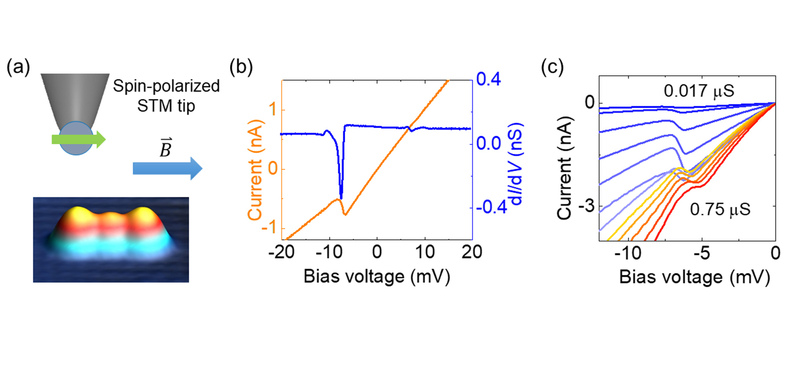A collaborative research project between Yan Shichao, an assistant Professor in School of Physical Science and Technology at ShanghaiTech University and Professor Sebastian Loth at Max Planck Institute in Germany discovered the spin-based NDR effect in antiferromagnetically coupled few-atom spin chains. Their research paper on the “Dynamical Negative Differential Resistance in Antiferromagnetically Coupled Few-Atom Spin Chains” was published in Physical Review Letters on November 21, 2017.
Negative differential resistance (NDR), referring to a decrease in current as voltage increases, is an important effect that has been widely used in modern electronic devices. In 1957, Japanese scientist Leo Esaki discovered the NDR effect in tunneling diode, which was the first demonstration of electron tunneling in solids. Esaki was awarded the Nobel Prize for this discovery in 1973.
NDR is usually achieved by the shift or occupation of the electronic states, which requires the operating voltage to be on the scale of 1 volt. However, electrons also have spin degree of freedom. Exploring the spin-based NDR may enable low-power consumption spintronic devices.
Yan Shichao and his collaborators assembled a three-atom spin chain by scanning tunneling microscope (STM) atom manipulation technique. Then they measured the spin dependent tunneling current through this spin chain with spin-polarized STM, and they found strong NDR effect in this spin dependent electron tunneling processes. This spin-based NDR works at only a few millivolts and it is tunable with external magnetic field and magnetic interaction with the spin-polarized STM tip.
By further modeling the experiment, they found that this spin-based NDR was induced by exciting the spin chain into an excited spin state that suddenly increased the magnetoresistance in the spin-polarized tunneling junction. This NDR effect may be useful for the applications of low-power consumption spintronic devices. Because of the sensitivity of this NDR to magnetic interaction, it has potential as the basis for atomic-scale magnetic sensors.
Read more at: https://journals.aps.org/prl/abstract/10.1103/PhysRevLett.119.217201
 (a) Schematic of the spin-polarized tunneling through the spin chain; (b) Spin-polarized tunneling current as a function of bias voltage (orange line) and the spin-polarized differential conductance spectrum (blue line); (c) Spin-polarized differential conductance spectra at different tunnel junction conductances.
(a) Schematic of the spin-polarized tunneling through the spin chain; (b) Spin-polarized tunneling current as a function of bias voltage (orange line) and the spin-polarized differential conductance spectrum (blue line); (c) Spin-polarized differential conductance spectra at different tunnel junction conductances.

